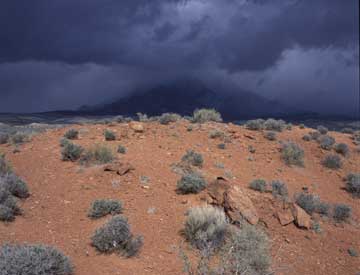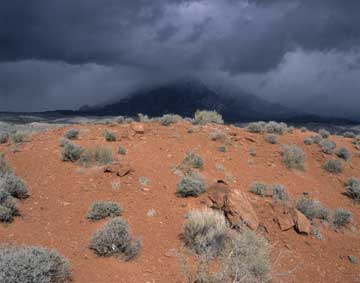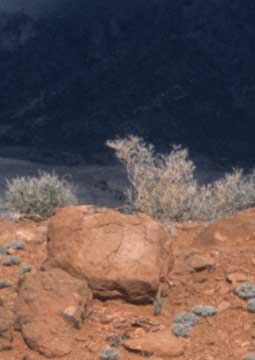Nikon 8000ED Scanner
First Impressions
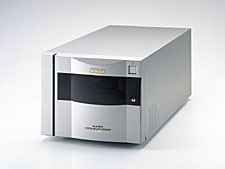
This report is of a brief hands-on test of the newNikon Super Coolscan 8000 EDscanner. ThePolaroid Printscan 120and theNikon 8000have been eagerly awaited during the spring of 2001 as they both potentially represent the first high-quality yetaffordablemedium format film scanners to be made available to photographers.
In mid-July 2001 my colleagueIan LyonsofComputer Darkroompublished a review of thePolaroid PrintScan 120scanner on his web site. Ian thinks very highly of the Polaroid. This left the other shoe to drop. What would the Nikon 8000 be like?
Just a couple of days later I received a call fromVistek, one of Canada’s largest professional imaging equipment dealers, saying that they had just received their first Nikon 8000,and would I be interested in having a look at it? After the better part of an afternoon testing the unit, here are my initial impressions. Please note that that’s all these comments are‚initial impressions.
Specs
I won’t detail the unit’s specifications here. You can read them by going to theNikon siteand clicking ondownload specs. The key points are that the scanner will handle film up to 6X9cm in size, including 35mm. It ships with three film holders; mounted 35mm, 35mm film strip and 120 roll film. There are optional glass carriers for all formats available as well. Windows and Mac software is provided, and the interface is an IEEE 1394 connection (Firewire). If you are running a PC that does not have a Firewire card, you will have to install one. There is no facility for a SCSII connection.
Scanning resolution is 4000 DPI and Density Range is rated at 4.2. (I always take this spec with a large grain of salt, as there is no industry agreed-upon standard for how it is measured. I have seen scanners with low DMax specs perform better than ones with high manufacturer’s claims. Don’t buy a scanner based on reading the spec sheet!)
In the U.S. the scanner ships with the full version ofAltamira’s Genuine Fractals 2.0. This software isnotincluded in the Canadian package. I don’t know at this time what Nikon’s plans are for Europe, Australia and elsewhere. Retail price is "around" USD $3,000.
The 8000ED can save scans with a number of different profiles, including Adobe RGB and Bruce RGB. This is the first time that I’ve seen a scanner ship with this wider gamut profile.
Point of Reference
Regulars to this site will know that my reference scanner is theImacon Flextight Photo. This is arguably the finest desktop scanner for medium format and 35mm film yet available. In my experience only a drum scanner can produce better results, and then not always and not by much. Ian has reported that the Polaroid 120 competes quite nicely with the Imacon but that the Imacon pulls ahead in ultimate quality. I was curious, of course, to see how the Nikon would compare and so this test includes a comparison with a scan of the same transparency on both the Nikon and the Imacon.
The Unit
My first impression was that this is quite a large box, over 19 inches in depth. The Imacon on the other hand is tall rather than deep, so it fits on a desktop with a bit make alacrity. On the other hand the Nikon is not as heavy as it looks, though the weight isn’t really an issue unless one is planning on moving it between locations frequently.
Set up went smoothly. The software was installed and the scanner connected to a Mac via the IEEE 1394 connection (Firewire). Very straightforward. I didn’t spend much time with the manual. It looks basic and not terribly detailed. It is in multiple languages. The most glaring issue with the documentation, which had me and everyone atVistekchuckling, is that the manual calls what we refer to in the English speaking world as "medium format", as "Brownie"film.
Now, maybe that’s what it’s called in Japan. But I haven’t heard the word "Brownie" used in photography for about 40 years. To refer to what essentially is a professional format film size as "Brownie" says something very curious indeed about Nikon, a company with pretensions of being international in their marketing. Common guys. Stop cheaping-out and hire professional translators.
The Film Holders
My first and really only negative comment about the Nikon 8000’s mechanical design, is the film holders. The unit ships with holders for mounted 35mm slides, uncut 35mm film strips and Brownie (oops‚medium format) film. I didn’t use the 35mm holders during my test. My issue though is with the 120 holder, though the 35mm holder had a somewhat similar design.
120 film is loaded into a channel that is secured on either side by folding gates. These gates snap into place with protruding pieces of plastic fitting into matching holes in the base. The fit is so tight that I was really quite fearful that I was going to break them when closing. Opening them was even worse, requiring real force. My concern is that in addition to appearing to be perilously close to requiring breaking force to open and close, eventually these fittings will wear and become less secure‚ just the opposite problem. It really wouldn’t have been all that difficult to design a locking fitting.
Two appreciated design features of the holder are rubberized edge strips that nicely hold the film in place during loading, and a sliding mechanism that applies tension to 120 film, stretching it width-wise to reduce buckling and improve overall focusing accuracy. This seemed to work quite well as no soft-focus areas were detected on several scans.
I was disappointed to see that the maximum scan length for medium format is 9cm. This makes it impossible to scan 6X12cm or 6X17 panoramics.
The Software
The scanning software,Nikon Scan 3.0,appears to be similar to that provided with the other current Nikon scanners like the 4000ED. I had no opportunity to explore this software in depth, but it looks competent. I did not test any of the "extra" features such as their ICE technology for removing dust or GEM for reducing film grain. Others have commented on this software on various forums around the Net and if you’re interested a search will turn up lots of opinions, both pro and con.
Comparing The Scans
The primary quandary that I faced in doing a comparison with the Imacon was that the Nikon is a 4000 DPI scanner while the Imacon Photo is 3200 DPI. I had three choices. Scan with the Nikon at 3200; res-down the Nikon 4000 dpi scan to match the Imacon; or compare scans that had a 25% difference in resolution. I decided to res-down the Nikon scans for my primary comparisons but I also referred to the original 4000 dpi scan when subjectively evaluating resolution.
This photograph of Mt. Hillers in southern Utah was taken in April, 2001 with aMamiya 7 IIand 65mm f/4 lens on Provia 100F.
Nikon 8000 Imacon Flextight Photo
The above are the test scans. This represents about 75% of the full frame as shot. I cropped the very bottom of the frame as it was uninteresting. These appear to be cropped ever so slightly differently, but that should make no difference in the evaluation. Otherwise they have been scaled to the same resolution.
Both scans are with all software adjustments set to either neutral or automatic. No sharpening or colour correction have been applied either in the scanning software or in Photoshop afterward. If you click on each of the pictures above you will see 10" wide versions, again uncorrected.
Nikon 8000 Imacon Flextight Photo
These two frames are crops at 100%; Actual Pixels. Any enlargement beyond this is empty and leads to pixelation. This would produce a 28" X 40" print from the Nikon at a printer resolution of 240 DPI. Again, both above and in the linked larger images, no sharpening, colour correction or other manipulations have been done. What you see is what I scanned.
Scan Evaluations
Here’s whatIsee.
The Nikon is capable of producing truly excellent scans. In terms of sharpness, resolution and contrast, rating the Imacon as a 10, I would rate the Nikon at 9.7. The Imacon isslightlysharper and hasslightlymore shadow detail.Slightly!
Frankly, the Nikon produces such high image quality that minor variances like what I’m describing simply are near the limits of ones ability to detect. When applying the usual processing tools in Photoshop, including the application of an appropriate amount ofUnsharp MaskandLevels / Curvesadjustments, these difference essentially disappear.
The Nikon is the winner in terms of scan speed. It took about 2.5 minutes for this particular scan while the Imacon took exactly 10 minutes. The Nikon’s preview was much slower though. It took 1 minute and 20 seconds to do a preview while the Imacon took 10 seconds!
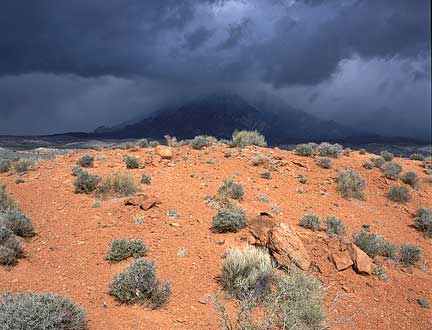 Mt. Hillers‚ Approaching Storm #2. April, 2001
Mt. Hillers‚ Approaching Storm #2. April, 2001
This is a final colour corrected and sharpened scan from the Nikon.
There’s no question that Nikon has a winner with the 8000ED. It has some flaws, as discussed above, but what product doesn’t? Compared to the Imacon at USD $10,000 it is less than a third the price. The Imacon Photo can handle film up to 6X17cm in length, has superior film handling capabilities and comes with one of the industry’s top-rated scanning software packages. Frankly, if I were selecting a scanner today I’d be tempted to choose the Nikon because of its significant price advantage. Only the reduced film handling capability would deter me.
The other contender is, of course, thePolaroid PrintScan 120. I have no personal experience with this unit, though as I mentioned at the beginning of this reviewIan Lyonsrates it very highly. My only concern with the Polaroid at this time (Summer 2001) is the state of health ofPolaroid Corporationitself. Its run into some financial difficulties and the company’s future consequently remains a bit uncertain.
Bottom line? If you’re looking for a very high quality medium format scanner at a reasonable price and can live with a maximum 6X9cm film handling capability, the Nikon Super Coolscan 8000ED may well be the scanner for you.
NB:This evaluation is based on a brief hands-on opportunity to test the 8000 at Vistek (for which I thank them). There may be issues and subtleties that only arise after the unit has been used for some length of time, and possibly as well only after its been on the market for a while. I don’t own an 8000 and therefore am not in a position to answer additional technical or operational questions. What I know about the scanner, and my impressions of it, are contained on this page. If an opportunity arises to do further evaluation or testing the results will be posted here and announced onWhat’s New.
I hope that you’ve find this report to be of interest. If you are not already aware of it you might be interested in finding out about my latest publishing venture,The Luminous Landscape Video Journal, a quarterly video magazine on DVD, featuring travel stories, product review like this one, and tutorials and interviews with famous photographers.
Letters from Readers
Hello Michael,
These are just some comments you might find useful.
1) Currently the LS-8000 only scans up to 6×9. However, the holders will actually hold at least 6×12 (can’t remember if 6×17 would fit). So, it’s possible that Nikon can update the software to handle larger film formats. Otherwise, stitching software could be used instead to combine two seperate scans.
2) I had an LS-8000 and was probably one of the first people in the US to take delivery of one (#2 on the waiting list at cameraworld.com). Unfortunately, the thing was riddled with bugs. The biggest one was that I was getting banding in scans. You’re Utah shot would have shown this perfectly in the sky if the sky were a bit lighter. Also, a number of people on the filmscanner list have had similar problems and one person has had the problem with two examples of the scanner. I had various software bugs also but I was able to overcome those.
3) I returned my LS-8000 in exchange for a Polaroid SS120. I’ve returned the SS120 because I felt the Nikon was very slightly sharper and, more importantly, Digital ICE really worked and I want it. Currently I’m waiting for another LS-8000 which I hope works better than the first.
Anyway, I hope these comments are useful and thanks for the great site. I’ve learned a lot.
Paul WilsonThe Filmscanner List
Hi Michael,
I read your review of the Nikon 8000ED, as well as the reader’s comment posted below your review. I use a Nikon 8000ED at work to produce custom prints. In regards to the banding that was mentioned in the reader’s comment, I have very seldom encountered this problem. When I do, it usually involves a high contrast situation. Nikon states that the banding occurs in these situations due to the way its tri-linear CCD scans. However, there is a check box in the scanner extras section that will force the scanner to perform the scan using a single linear CCD instead of the tri-linear CCD. The result is that the scan takes 3 times longer, but the banding disappears.
Ed Hamrick, author of the highly regarded VueScan software has just written to say that his latest version supporting the LS-8000 is now available. He also explains below why the scanner is limited to a maximum of 6X9cm scans and also the reason for some banding problems that have been reported.
Hi Michael,
I read your interesting review of the Nikon LS-8000, and thoughtyou’d like to know that I just released VueScan 7.1.11 with support for the LS-8000. I also learned a few things in reverse-engineeringthe commands that the scanner uses.
The film window for Medium Format is 200 mm long, but the scannerhardware is only capable of mechanically scanning a 90 mm long piece, starting at any point in the 200 m window. This is because the scanner has two motors – one to roughly position the filmholder before the scan starts, and the other to do 4000 dpi stepping.
The 4000 dpi stepper motor only has 90 mm of travel, just likethe SprintScan 120. The banding problem appears to be due to Nikon using the same 10000 element calibration data for each pixel position in the CCD. Since there are three separate CCD lines in the LS-8000 (there’s only one on all other CoolScan scanners), any small difference in sensitivity between the N’th CCD pixel in each of the three CCD lines can cause streaking when the same calibration data is used for each of the three CCD lines.I solved this problem in VueScan by only using one CCD line.
You can download VueScan 7.1.11 from:http://www.hamrick.com/vsm.html
Regards,
Ed Hamrick
![]() 24 October, 2001
24 October, 2001
At the beginning of this month Imacon announced that they had reduced the price of theImacon Flextight Phototo US$6,495 from its original price of $9,995. I have just been informed that Imacon is currently offering a limited-time US$1,500 mail-in rebate which effectively reduces the net cost to the end-user to $4,995.
This 50% price reduction is dramatic, and brings theFlextight Photointo the price range of a much broader range of prospective users. It also reduces the price gap with theNikon LS-8000andPolaroid SprintScan 120to the point where purchasing the superior Imacon becomes a not unreasonable choice.
You May Also Enjoy...
The Luminous Landscape Guide to Lightroom 3 Preview
Duration 1:23file size - 15.3 MBVideo size is 640 x 360p Actual download HD video size is twice this size: 720PExcerpt from 'Upgrade Catalog' The
Beauty is more than skin deep. Thoughts on the Leica T
The Leica T Leica T 1/15th @ f7.1, ISO 400 You may have seen the tee shirt,‘Life is uncertain - start with dessert’. Well, that’s
